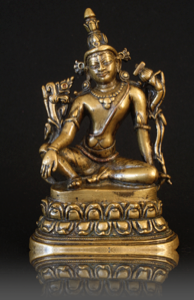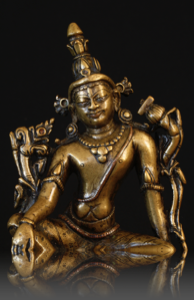A16. Manjusri, 13.7cm, copper alloy, silver and copper, Northeast India, Pala, 12th century.
Manjusri is the Bodhisattva of Wisdom and as such he is depicted here seated in the posture of royal ease [Rajalalitasana] with lotuses flowering at each shoulder, that at his left supporting the Prajnaparamita or book of wisdom. His lower lip is copper inlaid and he wears a copper inlaid sacred thread [yajnopavita]. His eyes are inlaid with silver one retaining its copper inlaid pupil and his dhoti is decorated with finely incised double stripes and small stippled rosettes. A tang projecting from the rear indicates that the sculpture was probably formerly attached to a mandorla.
The sculpture’s lustrous patination and traces of blue pigment in the hair indicate that he was once worshipped in Tibet rather than having been buried as were many Pala metal sculptures.
Considerable discussion has taken place in recent years as to whether sculptures like and including this example were in fact made in Pala Northeast India or were made in Tibet in a Pala style. Of four related sculptures, the closest stylistically is presently in the Jokhang in Lhasa and is described as North-Eastern Indian, Pala style, 12th century. This image is published in Jokhang: Tibet’s most sacred Buddhist Temple by Gyurme Dorje, Tashi Tsering, Heather Stoddard and Andre Alexander, Hansjorg Mayer, London and Bangkok, 2010, illustration 1D on page 252. It has also been reproduced on the CD distributed with Ulrich von Schroeder’s book 108 Buddhist Statues in Tibet. Also 1D.
Another related image of Maitreya is illustrated in Uhlig, “On the Path to Enlightenment”, described as “Northeast India, Pala dynasty, 11-12th century”, No: 38.
A third related sculpture of Syamatara is illustrated in von Schroeder, Buddhist Sculptures in Tibet, volume 2, described as “Tibetan Monastic Period: Pala Style, circa 12th Century” 288A-B.
A fourth related sculpture of Maitreya is illustrated in The Spiritual Heritage of Tibet: Buddhist Art in the Nyingjei Lam Collection by David Weldon and Jane Casey Singer, fig.18, page 55, described as Tibet, circa 12th century
The underneath of this sculpture shows no evidence of it ever having been sealed giving further support to a Pala attribution.
PROVENANCE: Sotheby’s, London, 23rd November, 1987




